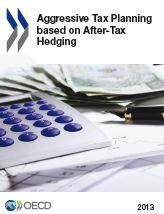Tax
Aggressive Tax Planning based on After-Tax Hedging
 |
While after-tax hedging is not, of itself, aggressive - being generally a straightforward risk management technique - the report recognises that it can also be used as a feature of ATP schemes. ATP schemes based on after-tax hedging pose a threat to countries’ revenue base.
> English > Italian |

Recommendations
The report recommends that countries concerned with ATP schemes based on after-tax hedging should:
• Focus on detecting these schemes and ensure that their tax administrations have access to sufficient resources (in particular expertise in financial instruments and hedge accounting) to detect and examine in detail after-tax hedging schemes.
• Introduce rules to avoid or mitigate the disparate tax treatment of hedged items and hedging instruments.
• Verify whether their existing general or specific anti-avoidance rules are suitable to counter ATP schemes based on after-tax hedging and, if not, to consider amending those rules or introducing new rules.
• Adopt a balanced approach in their response to after-tax hedging, recognising that not all arrangements are aggressive, that hedging in and of itself is not an issue and that ATP schemes based on after-tax hedging may necessitate a combination of response strategies.
• Continue to exchange information spontaneously and share relevant intelligence on ATP schemes based on after-tax hedging, including deterrence, detection and response strategies used, and monitor their effectiveness.

Further reading
- Hybrid Mismatch Arrangements (2012)
- Corporate Loss Utilisation through Aggressive Tax Planning (2011)
- Tackling Aggressive Tax Planning through Improved Transparency and Disclosure (2011)
Related Documents